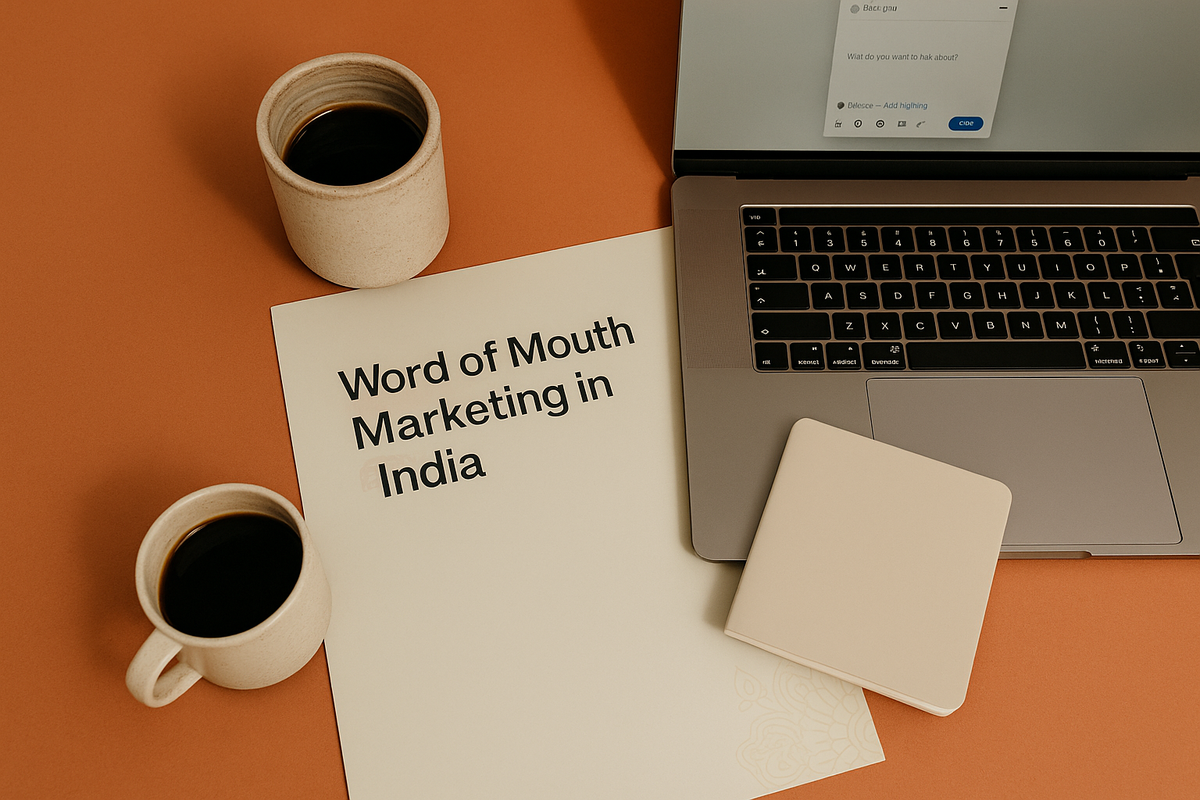Word of Mouth Marketing in India: 7 Strategies That Actually Work in 2025

Paid ads, influencers, emails... all good. But for Indian D2C brands, the most durable growth still comes from customers talking to other customers. Word-of-mouth (WOM) turns trust into traffic, often at a lower CAC and with better LTV.
This guide reframes WOM for India's realities. WhatsApp first discovery, UPI payouts, COD/RTO nuance, festive spikes, and Tier 2/3 creators. And gives you seven practical plays you can run this quarter.
What is word of mouth marketing?
WOM is when real customers recommend your product to people they know. Friends, family, colleagues, communities. Your job is to make the experience worth talking about and make sharing effortless.
Why this matters in India:
People trust people. Global research consistently shows recommendations from friends and family are the most trusted channel (c. 88% trust), outranking ads by a wide margin.
WhatsApp is where conversations happen. It reaches hundreds of millions in India, so sharing links, codes and stories there is natural.
UPI has made paying and rewarding instant: July 2025 saw ~19.5 billion UPI transactions worth ₹25.1 lakh crore.
COD is still big. In FY2024, COD drove 40%+ of India B2C e-com GMV and ~27% of shipments. Which changes how you design referral incentives and manage RTO.
4 reasons WOM is powerful for Indian D2C
Trust compounds
Recommendations feel real, not "ad-y," so they convert better. Especially for first-time buyers and new categories.
New revenue, not just repeat
Referrals unlock friends of your buyers. People you wouldn't have reached via ads or marketplaces. And much of that revenue is incremental.
Community flywheel
Great experiences create advocates who post reviews, reels, and how-tos. Done right, you get a creator base you didn't have to hire.
Scalable with systems
WOM isn't "hope." With the right prompts, tracking, incentives, and payout rails (UPI), you can scale it predictably.
7 word of mouth strategies you can start today
1) Tune the full customer lifecycle (reach → acquisition → conversion → retention → loyalty)
Reach: Be clear about the problem you solve. Use short, benefit-first hooks on Instagram/Reels and YouTube Shorts. Answer real questions on product pages and blogs.
Acquisition: Show social proof up front. If you sell on marketplaces, mirror those reviews on brand.com (where allowed) and add "How it works" explainers.
Conversion: Remove friction. Auto-apply first-order codes from referral links. Offer a small prepaid incentive (UPI) while keeping COD visible for trust.
Retention: Post-purchase WhatsApp and email flows that teach usage, set expectations, and invite honest feedback.
Loyalty: Spotlight customers, run small community challenges, and layer in refer-a-friend.
Tip: Watch RTO by pincode and payment type. In India, prepaid returns are far lower than COD (industry reports show COD returns can be >2x prepaid). Tune policies accordingly.
2) Launch (or fix) your referral program
Make it native to how Indians shop and share.
Offer shape: Keep "Give ₹X, Get ₹Y" simple. Use INR bands that protect margin. Start with ₹150–₹300 off or 8–12% discount for mid-ticket products, then test.
Flow: Post-purchase prompt → WhatsApp share → friend lands on a page with auto-applied benefit → UPI + cards default on checkout → COD still visible.
Payouts: Pay advocates weekly via UPI; share simple statements for tax records.
Guardrails: Block duplicate devices, cap monthly rewards, and set cool-offs to reduce abuse.
Brands use ReferRush to trigger one tap WhatsApp shares, auto apply referral discounts at checkout, attribute orders cleanly, and pay advocates via UPI with TDS handling. All useful in India's context.
3) Turn social into WOM, not just reach
UGC prompts: Ask for 15–30s "first use" clips, routine demos, or before/after stories. Incentivise with points or small credits, not just discounts.
Community loops: Share the best posts weekly; credit the creator; add their code.
Vernacular variants: Hindi/Tamil/Telugu/Bengali captions widen reach beyond metros.
Festival playbooks: Pre-Diwali, Rakhi, Eid, Pongal. Plan UGC themes two weeks early and refresh assets right after salary week.
4) Build an "everyday influencer" bench
The Indian influencer market is sizeable and growing (₹3,600+ crore in 2024; projected +25% in 2025). But micro and nano creators in Tier 2/3 often outperform on cost-per-order and trust.
Mix: 70% nano/micro (community trust), 20% mid (category reach), 10% macro (bursts).
Briefs: Clear claims, 2–3 demo beats, and a single CTA.
Measurement: Track click→add-to-cart→order and RTO, not just views. Shift budget to creators who drive prepaid orders and lower RTO.
5) Engineer reviews and referrals together
Shoppers still rely on ratings/reviews, even as many feel platform reviews are biased. Balance this by collecting verified, usage-rich reviews and showcasing them where hesitation is highest (new SKUs, higher AOV, non-metro traffic).
Play: 10 days after delivery, ask for a review with a small credit. 20 days later, invite the reviewer to refer a friend (different reward).
Placement: Put reviews on top of PDP, in emails, and inside WhatsApp catalogs where possible.
6) Do tiny extras people love (and share)
A handwritten "Welcome to the fam" postcard on first order.
Small freebie that helps usage (scoop, travel pouch, tester).
Surprise UPI cashback on the second order.
Fast, human support on WhatsApp when something breaks.
These are low-cost, high-share moments that create stories customers retell.
7) Respect COD (and still nudge prepaid)
COD is not going away in 2025. It still drives a big chunk of GMV, but it's also where RTO risk lives.
Keep COD visible (trust), but:
Add OTP on delivery for first-time buyers in riskier pincodes.
Offer small prepaid nudges (₹50–₹100 UPI cashback or free shipping).
Show expected delivery dates clearly in Tier 2/3; failed delivery attempts fuel RTO.
For affiliates: higher commission on prepaid, slightly lower on COD. Explain why.
Two quick specific playbooks
Playbook A: WhatsApp + UPI WOM loop
A skincare brand triggers a WhatsApp prompt right after delivery confirmation. The buyer shares a smart link; friend gets ₹200 auto-applied at checkout; the advocate receives UPI payout every Friday with a simple statement for tax filing.
Result: more shares, faster rewards, fewer tickets. Because the flow matches how Indians already chat and pay.
Playbook B: Festive & salary-week timing
An apparel label refreshes creatives and referral hooks the week before Navratri and the day after salaries hit. Micro creators in Indore, Lucknow and Jaipur run try-on reels with "Give ₹250/Get ₹250" codes; COD stays on but prepaid gets free express shipping.
During the Diwali rush (which contributes a disproportionate share of annual GMV), this cadence maximises intent without heavy discounting.
Implementation checklist
- Define 3 KPIs: affiliate/prepaid conversion, AOV from referral traffic, net revenue after returns.
- Wire your flows: post-purchase WhatsApp prompt, referral landing with auto-applied code, UPI payouts weekly.
- Guardrails: device/ip checks, monthly caps, cool-off after refunds.
- UGC kit: 10 hooks, 5 story frames, 3 reel templates, vernacular captions.
- Influencer mix: onboard 25 nano/micro creators across Tier 2/3; brief and track on add-to-cart and orders, not views.
- Reviews → referrals: verify reviews, then invite to refer.
- COD controls: OTP on delivery for first-time, small UPI nudge, pincode-level rules.
- Festive calendar: build assets and offers two weeks before festivals and salary week.
A gentle word on tools
Use whatever stack fits your brand. If you need an India-native example, ReferRush supports one-tap WhatsApp sharing, auto-applied referral benefits, clean attribution, and UPI payouts with TDS handling. Useful for the Indian merchant space. No hard sell, just what works here.
FAQs
Do we really need COD in a WOM program?
Keep it, but manage risk. COD still powers a large share of GMV; use OTP on delivery, small prepaid nudges, and pincode rules to reduce RTO while preserving trust.
What's the best way to pay advocates?
UPI weekly is the smoothest, with simple payout statements for tax records. It matches how creators and customers already transact.
Are reviews still worth the effort if shoppers distrust them?
Yes. Indians still check reviews a lot; the fix is verified, usage-rich reviews and transparent moderation. Then invite reviewers to refer a friend.
Big influencers or micro creators?
Both. But in India, nano/micro creators in Tier 2/3 often deliver better cost-per-order and trust. Build a bench and shift budget to what converts.



